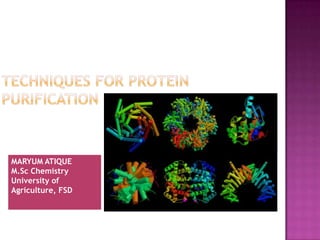
Techniques for protein purification
- 1. MARYUM ATIQUE M.Sc Chemistry University of Agriculture, FSD
- 2. Protein purification is a series of processes intended to isolate a single type of protein from a complex mixture. Protein purification is vital for the characterization of the function, structure and interactions of the protein of interest. The starting material is usually a biological tissue or a microbial culture. The various steps in the purification process may free the protein from a matrix that confines it, separate the protein and non-protein parts of the mixture, and finally separate the desired protein from all other proteins.
- 3. Separation steps may exploit differences in (for example) protein size, physicochemical properties, binding affinity and biological activity.
- 4. preparative analytical Preparative purifications aim to produce a relatively large quantity of purified proteins for subsequent use. Examples include the preparation of commercial products such as enzymes (e.g. lactase) Analytical purification produces a relatively small amount of a protein for a variety of research or analytical purposes, including identification, quantification
- 5. An analytical purification generally utilizes three properties to separate proteins. First, proteins may be purified according to their isoelectric points by running them through a pH graded gel or an ion exchange column. Second, proteins can be separated according to their size or molecular weight via size exclusion chromatography or by SDS-PAGE (sodium dodecyl sulfate-polyacrylamide gel electrophoresis) analysis Thirdly, proteins may be separated by polarity/hydrophobicity via high performance liquid chromatography or reversed-phase chromatography.
- 6. Extraction Depending on the source, the protein has to be brought into solution by breaking the tissue or cells containing it. There are several methods to achieve this: Repeated freezing and thawing, sonication, homogenization by high pressure, filtration, or permeabilization by organic solvents.
- 7. In bulk protein purification, a common first step to isolate proteins is precipitation with ammonium sulfate (NH4)2SO4. This is performed by adding increasing amounts of ammonium sulfate and collecting the different fractions of precipitate protein. Ammonium sulphate can be removed by dialysis. The hydrophobic groups on the proteins gets exposed to the atmosphere and it attracts other protein hydrophobic groups and gets aggregated. Protein precipitated will be large enough to be visible. One advantage of this method is that it can be performed inexpensively with very large volumes.
- 8. Usually a protein purification protocol contains one or more chromatographic steps. The basic procedure in chromatography is to flow the solution containing the protein through a column packed with various materials. Usually proteins are detected as they are coming off the column by their absorbance at 280 nm.
- 9. Using porous matrix Based on different sizes of proteins
- 10. Anion exchange resins (positive charge ) separate negatively charged compounds cation exchange resins (negative charge) separate positively charged molecules
- 11. Affinity Chromatography is a separation technique based upon molecular conformation resins have ligands attached to their surfaces which are specific for the compounds to be separated. ligands function in a fashion similar to that of antibody-antigen interactions.
- 12. high pressure to drive the solutes through the column faster. diffusion is limited and the resolution is improved. The most common form is "reversed phase" hplc, where the column material is hydrophobic. The proteins are eluted by a gradient of increasing amounts of an organic solvent, such as acetonitrile. The proteins elute according to their hydrophobicity. After purification by HPLC the protein is in a solution that only contains volatile
- 13. Resins used in the column are amphiphiles with both hydrophobic and hydrophilic regions. The hydrophobic part of the resin attracts hydrophobic region on the proteins. The greater the hydrophobic region on the protein the stronger the attraction between the gel and that particular protein.
- 14. Gel electrophoresis is a common laboratory technique that can be used both as preparative and analytical method. The principle of electrophoresis relies on the movement of a charged ion in an electric field. In these conditions, the proteins are unfolded and coated with negatively charged detergent molecules. The proteins in SDS-PAGE are separated on the sole basis of their size. In analytical methods, the protein migrates as bands based on size. Each band can be detected using stains such as Coomassie blue dye or silver stain. Preparative methods to purify large amounts of protein require the extraction of the protein from the electrophoretic gel. This extraction may involve excision of the gel containing a band, or eluting the band directly off the gel as it runs off the end of the gel.
